Which pond pump do I need for my pond?
Choosing the right pump for your garden pond can be quite daunting. A pond with fish should have a pump that provides filtration. Larger ponds will require a much larger pump and separate filter.
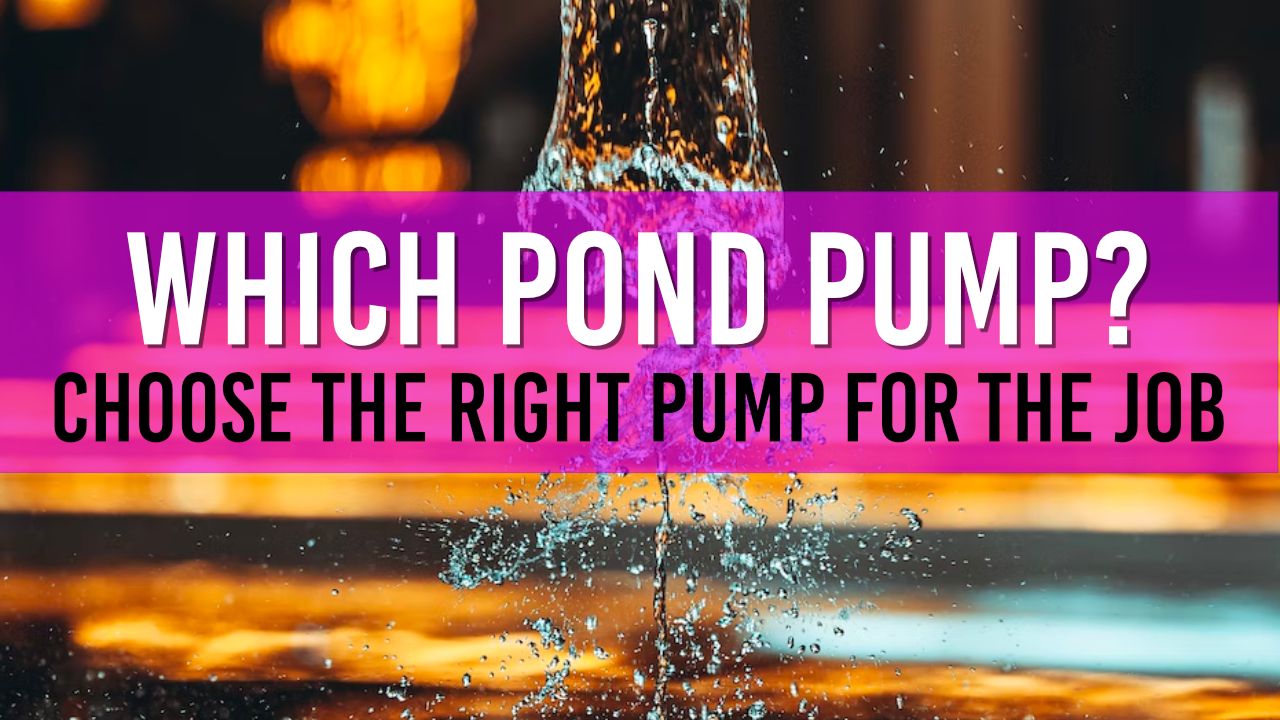
Table of Contents
For any new pond owner the choice of pond pumps can often be completely overwhelming and often raises the question “which pond pump do I need?”. Why can a pump cost less than £15 which produces the same amount of litres per hour compared to a £400 pump. I know when I built my first pond I felt like I cheated the whole pond supply industry by buying a £12.99 pump instead of the better £149.99 filter pump one.
Which pond pump should I buy?
Deciding on what type of pond pump should be initially based around the following questions, please refer to the questions you should be asking before deciding which pond pump to buy.
What size is my pond?
If this is your only pond pump, you need to use a pump that can cycle at least all your pond literage every hour. Calculate the amount of pond litres using an online tool, then purchase a pump that matches or exceeds.
Is the pump needed to provide filtration?
If you don’t plan adding an external filter box and want an “all in one” solution, then choose an all-in one pond pump.
Is this pump just for a water fountain?
Choose a pond fountain pump which has a long vertical spout to project water out of the top of your pond.
Does your pond have lots of fish or algae?
If your pond pump has lots of algae / fish then ideally you will need a good quality pond pump with a pump cage. This will prevent your pump from becoming blocked quickly.
Looking to save money on my pond pump costs
The easiest way to reduce your pond running costs is by choosing a lower wattage pond pump – but you must ensure it is still pumps your pond water volume every hour. Alternatively, purchase a variable flow pond pump which you can slow down to reduce running costs.
In this article, I will go through each type of pond pump you can purchase, and what their main functions really are. Hopefully after reading you will be better equipped to choose the right pond pump for you pond.
All In One Pond Pumps
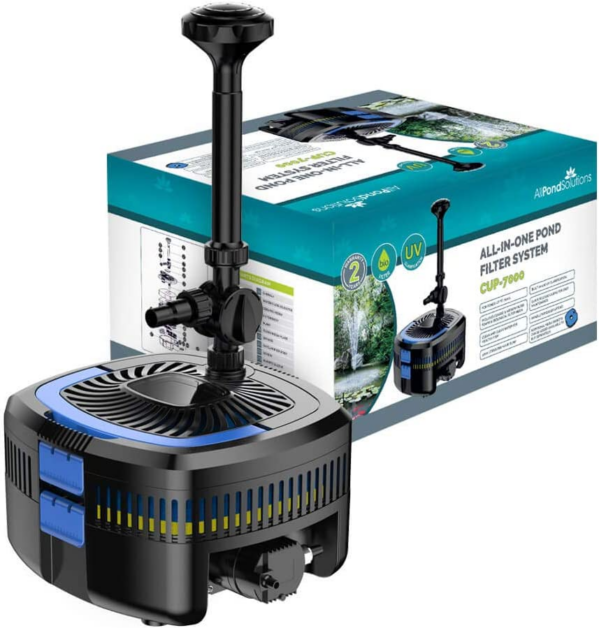
Like the name suggests “all in one” pumps contain everything you need in 1 single unit. Most ponds will have a separate filter box, UV Lamp, Pipes and of coarse the pump; All-in one pumps just require an electric supply and away it goes.
All In One Pumps contain all the required filtration units:
- Pump
- Filter Media
- UVC Lamp
There is no limitation on the type of pond you can place one of these pumps into however I would suggest they are more suited to ponds that do not contain KOI / Sturgeon due to the limited filtration they provide. If you have a wildlife or “small” fishpond, the complete all in one units would be perfect.
Pump Suitability
✅ Goldfish Ponds
✅ Wildlife Ponds
✅ Water Features
❌ Koi Ponds
❌ Highly Stocked Ponds
❌ Shallow Water
Pros and Cons of All In One Pumps
Pros:
- Fast Installation.
- No need for PVP Pipes.
- Only requires electricity supply.
- Reduced Risk of Leaks.
- Can connect to waterfall or fountain.
- Perfect for small ponds with limited space.
Cons:
- High Upfront Cost.
- Not as effective compared to separate filter.
- Time consuming to clean.
Feature Pond Pumps
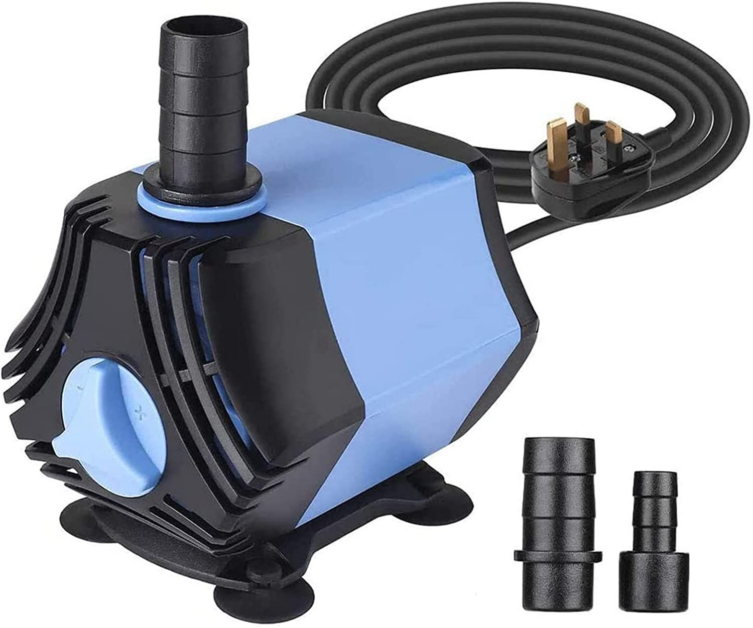
Feature pond pumps often catch pond owners out when they are looking for the perfect “cheap” pump for their garden pond (just like me). Very compact in size and can push some serious litres per hour – they should only be used for pushing water to a waterfall or other water feature, not to be used as the primary filter box feeder.
For under £20, feature pumps are placed inside your pond (generally the upper level) and connect to your electric supply with by plug or straight into your external power switch box. Connect up to your water feature / waterfall using PVC piping and switch on.
Suitability
✅ Water Feature / Waterfall
✅ Wildlife Ponds
✅ Shallow water ponds
❌ Not to be used as main filtration feeder
❌ Ponds with lots of blanket weed
Pros and Cons of Feature Pond Pumps
Pros:
- Very Cheap Pump.
- Small and Powerful.
- Perfect for Water features.
- Good Price to Lph Ratio
Cons:
- Not suitable for filtration.
- Easily blocked.
Fountain Pumps
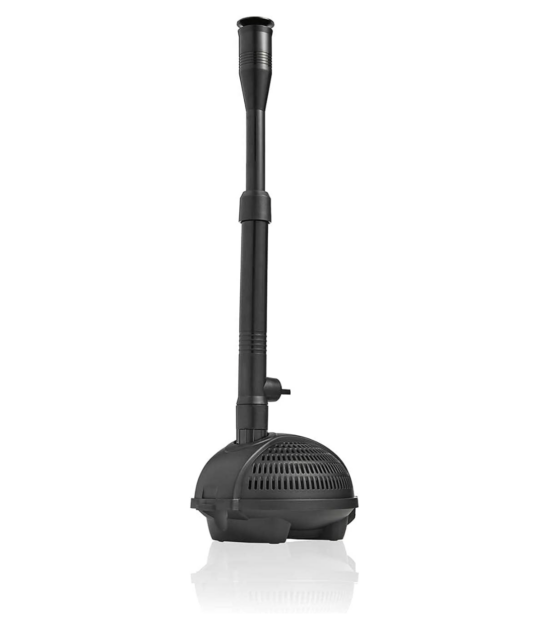
Adding a fountain to your pond is a common goal for many pond owners, the sound of water droplets splashing into the water adds some incredible elegance to your outside water garden. Fountain pumps can provide you with this effect and so much more with their long extending spouts.
As mentioned in my article “How to add more oxygen to my pond“, I go over the importance of breaking the water surface tension to allow oxygen to filter through for healthier fish and plants.
Similar to all in one pumps, fountain pumps only require a power cable however they generally have very little filter media (if any) and contain no UVC lamps. Their main purpose is to suck water and expel it through different attachments back into your pond.
Suitability
✅ Wildlife Ponds
✅ KOI Ponds*
✅ Ponds of all sizes*
❌ Not to be used as main filtration feeder
❌ Ponds with lots of blanket weed
* Not to be used as the main filtration pump.
Pros and Cons of Fountain Pumps
Pros
- Great visual effect.
- Only requires power.
- Extendable spout for deeper ponds.
- Multiple fountain displays.
- Improves pond oxygen levels
Cons
- Not suitable for filtration.
- Can become clogged easily.
- Requires perfect level for even spray.
Filter Pumps
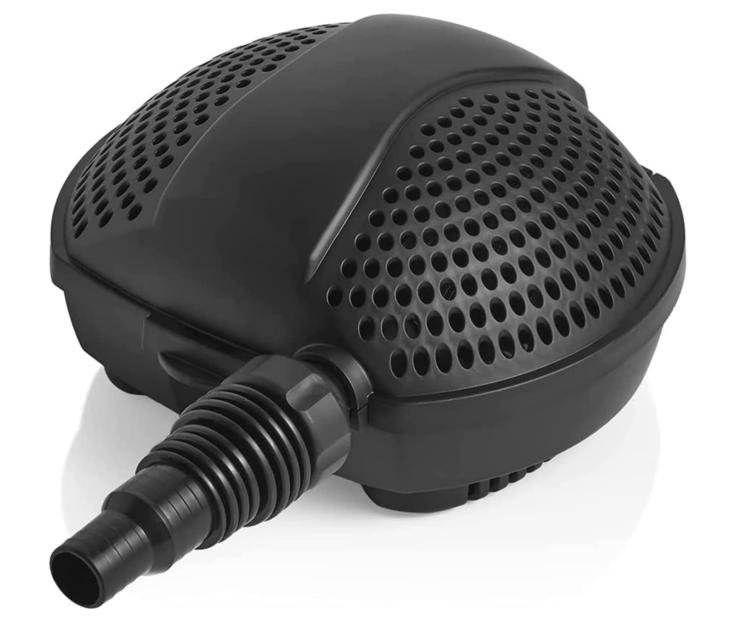
Filter pumps are the most popular type of pond pump. Unlike other pond pumps they are high powered and are usually encased in a cage to prevent blockages from algae / debris that is in your pond water.
Filter pumps require an electricity supply and take water from your pond using PVC piping to an external filter for cleaning.
Investing in a high quality filter pump will ensure that it is able to cope with increased fish waste, debris and algae without becoming blocked. Filter pumps will not have any sponges, or vertical spouts for fountains.
Suitability
✅ All Types of Ponds
✅ KOI Fry Ponds
✅ Ponds of all sizes
❌ Water fountains
Pros and Cons of Filter Pumps
Pros:
- Huge Range of Pumps.
- Suitable for Small, Medium & Large Ponds.
- Competitive Pricing.
- Variable flow pumps available.
- Complete with cage to prevent blockages
Cons:
- Requires external Filter Box.
- Requires external UVC.
- Requires PVC Tubing.
- Much larger footprint
Conclusion – So which Pond Pump should I buy?
I hope you found this article interesting and has helped you decide which type of pump you feel would be best for your pond. Some pond owners will often choose a pump that is more convenient for “them”, rather than the improving the environment for their fish. If you decide on an “All in One” pond pump, be prepared to clean it it regularly if you start to stock your pond with more fish (including KOI). If you just decide to add a fountain pump, be prepared for algae blooms in the summer months.
For me personally, I much prefer to focus on clear healthy water over fountains ensuring my pond (and surrounding area) contains:
- Filter Pump
- External Filter
- External UVC
Once I am happy with the quality of my water, I begin to add “features” and is the reason I also have a small decorative fountain pump in the centre of my pond.

